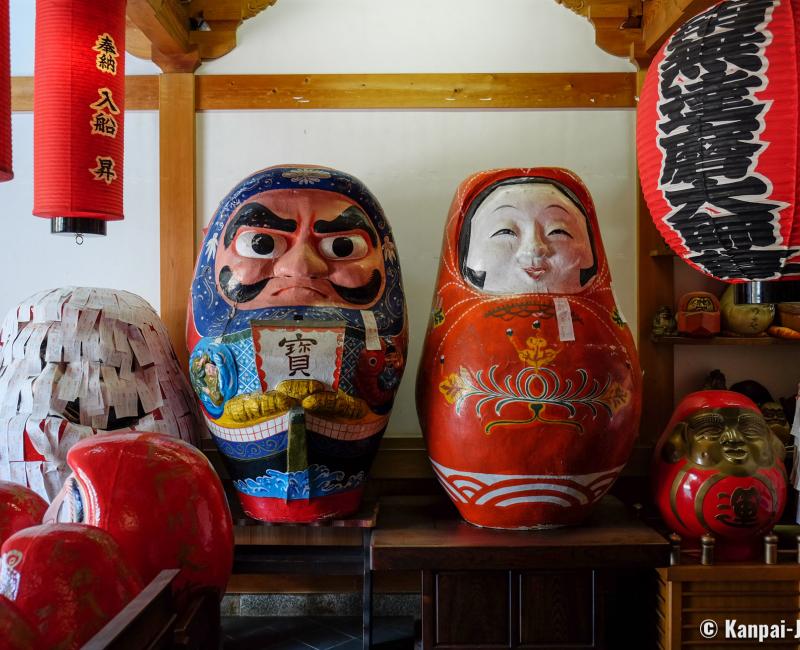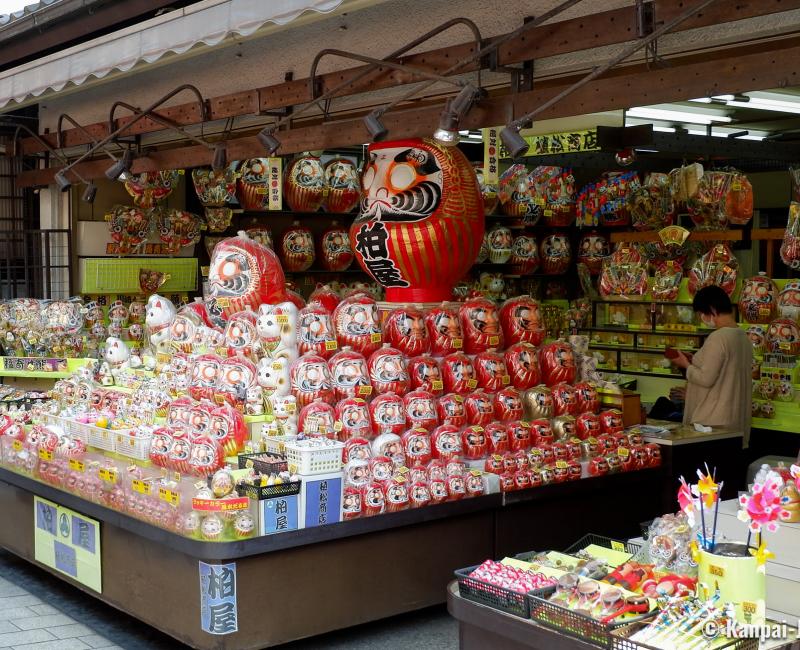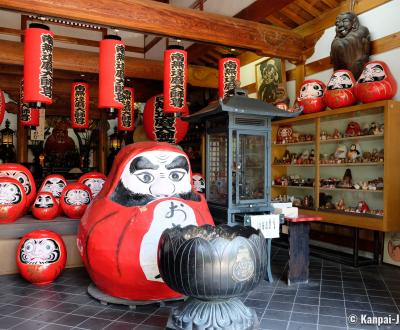Daruma
An Eye on Happiness and Success
Daruma dolls are traditional Japanese lucky charms that foreign tourists love to bring back as souvenir from Japan, or as a decoration like the classical maneki-neko and kokeshi doll. It is used to make a wish at the beginning of the year and symbolizes resolution and perseverance in achieving goals.
Daruma is the Japanese name of Bodhidharma, an Indian 6th century Buddhist monk, who spread Chan Buddhism in China. His teachings were introduced in Japan under the name of Zen in the 12th century. It is also said that he was at the origin of the practice of martial arts in the famous Shaolin Monastery.
The invention of the Daruma doll, the traditional lucky-charm, was attributed to Takasaki’s Shorinzan Daruma-ji temple in the 17th century. Its typical round shape, without legs or arms, originates from the legends associated to Daruma: his limbs atrophied after an uninterrupted meditation of nine years facing a wall. It is said his eyes are protruding because he cut his eyelids himself over frustration as he fell asleep during this period and for it does not happen again.
This specific shape is a symbolization of the idea of perseverance. Indeed, like a roly-poly-toy (in Japanese okiagari koboshi 起き上がり小法師), it always returns to its initial position thanks to the weight at its bottom. It is the embodiment of the expression nana-korobi ya-oki (七転び八起き) "fall 🍁 down 7 times, get up 8" that means that one must always go on despite adversity or misfortune.

A caricatural portrayal
In the Buddhist tradition and as a doll, Daruma is pictured as a middle-aged man, with a beard and abundant brows, ludicrous face features and wide eyes, and draped in a monk’s red robe also covering his head.
Daruma’s portrait is a prevalent motif in Japanese art, and especially for etching painter Hokusai, who produced several of them, and especially some gigantic ones. He painted a Great Daruma in 1817 for Hongan-ji Nagoya Betsuin temple, that was 18 meters long and 11 meters wide, almost 200m²! The artwork was unfortunately destroyed during WWII bombings.
Regarding the doll itself, it is usually made with papier mâché, by artisans in temples and shops specialized in crafting Japanese dolls. There are of course a variety of different dolls across the regions, with various colors, facial hair, expressions, and face features. Daruma can also be represented under a feminine or animal appearance, or as a mascot.
Whatever its size, however, the Daruma doll is always of a round shape and its eyes are empty.

How to use a Daruma doll?
To attract good fortune, just follow these simple steps:
- Buy a Daruma doll at a temple;
- Make your wish mentally then paint the left eye’s iris – or have it done by one of the temple’s monk (for a fee);
- Display the doll on an easily visible place at home to be frequently reminded of the goal you want to achieve;
- Paint the right eye when the wish comes true or when the goal is achieved.
After one year, the Daruma doll can be brought back to the temple. It will be displayed there with its two eyes blackened, as a testimony of its owner’s success, or burnt at the end of the year by the monks, to indicate a change of strategy is necessary.
It is possible to choose the color of the Daruma doll according to the goal to achieve. The red one is the most common and versatile, as red is a good fortune and protective color, and also the color of the monks’ robes. However, a large choice of colors is available to correspond to specific needs:
- A black Daruma doll to bring success in business;
- A blue for success in school;
- A green for health, developing skills or talents;
- A yellow of golden for monetary wealth;
- A light pink for love relationships;
- A violet for health and longevity;
- A white Daruma encourages students who take exams or martial artists.
The meaning intended for the color may vary locally; it is something to check when buying the Daruma doll.

When and where to buy a Daruma doll?
The purchase of a Daruma doll is possible all year long at Japanese temples, as well as in neighboring shopping streets. For example:
- In the streets near Kawasaki-daishi temple in Kawasaki, in Tokyo’s southern suburb;
- At Katsuo-ji temple, in Minoh in the north of Osaka;
- At Daruma-dera temple (official name: Horin-ji), in the north of Kyoto, its nickname originates from a pavilion Daruma-do, that was built after WWII for the purpose of sheltering thousands of Daruma dolls offered by worshippers, as ex-voto. It is said to house the oldest doll in Asia, and the place abounds with details that are tribute to Bodhidharma: ornamentation of roofs, paintings, calligraphies.
To take up to the tradition, it is best to buy a Daruma doll during a dedicated festival, the daruma-ichi (だるま市, "Daruma market"), of which three are particularly renowned:
- Nanakusa Taisai at Shorinzan Daruma-ji temple (少林山七草大祭) in Takasaki in Gunma prefecture, held on January 6 and 7, it is visited each year by 200,000 persons. The dolls made for this temple are worshipped as deities bringing happiness, and more than one million of them are sold, for the wish of happiness only.
- Bishamonten Taisai (毘沙門天大祭) at Myoho-ji temple in Fuji 🗻 city in Shizuoka prefecture at the foot of Mount Fuji. The market, which is the largest Daruma dolls fair in Japan, spans three days between the end of January and early February (dates vary according to the former lunar calendar). Five hundred stalls and shops from all over the country form a one-kilometer-long market selling Daruma dolls and traditional lucky charms.
- Yakuyoke Ganzan-daishi Taisai (厄除元三大師大祭) at Jindai-ji temple in Chofu in Tokyo’s west suburb, on March 3 and 4, visited by 100,000 persons each year. Inside the left eye, monks paint a Sanskrit character meaning "beginning." When the goal is achieved the right eye will be painted with the character for "end."


